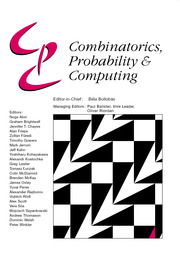Crossref Citations
This article has been cited by the following publications. This list is generated based on data provided by Crossref.
Bucić, Matija
Korándi, Dániel
and
Sudakov, Benny
2021.
Covering Graphs by Monochromatic Trees and Helly-Type Results for Hypergraphs.
Combinatorica,
Vol. 41,
Issue. 3,
p.
319.
Bradač, Domagoj
and
Bucić, Matija
2023.
Covering random graphs with monochromatic trees.
Random Structures & Algorithms,
Vol. 62,
Issue. 3,
p.
545.
Allen, Peter
Böttcher, Julia
Lang, Richard
Skokan, Jozef
and
Stein, Maya
2024.
Partitioning a 2-edge-coloured graph of minimum degree 2n/3+o(n) into three monochromatic cycles.
European Journal of Combinatorics,
Vol. 121,
Issue. ,
p.
103838.



